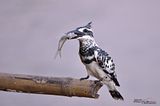One more year has finally come to an end. 2011 has been another fruitful year for birding, although not specifically for Beppu.This year saw me changing my camera body twice. The first time from an old Canon EOS 350D, which I'd been using for over 5 years, to a new EOS 550D in March. This new 550D unfortunately dropped into the mud at Sekinoe in May, and I was left birding without any camera for roughly 4 months before I got another 550D to replace the former one. It was the biggest tragedy that happened for me in 2011. At least it made me become much more conscious about the safety of my equipment.
The highlight of January was the 2 Black-necked Grebes (Podiceps nigricollis) that showed up in a small port behind my dorm. Both of them were in their non-breeding plumage with one of the birds having strangely deformed upper mandible. Photos and stories of the first individual can be seen here, and here for the second individual.
I also discovered another great birding place in Oita where over 100 Mandarin Ducks (Aix galericulata) gathered along with a few other species of ducks. It was a quiet curve of Oita River sheltered by large oak trees near Taromaru. Even though I couldn't get close to the birds, it was an absolutely wonderful experience observing them performing courtship display and relaxing in the afternoon light. More photos can be seen here.
The pair of Bean Geese (Anser fabalis) that was staying at Sekinoe since late October 2010 was still presenting well until early March. It was sad that I couldn't observe them until they left because I had to go back to Thailand during the spring vacation starting from February. The above photo was taken on January 15, showing the smaller Tundra Bean Goose (Anser fabalis serrirostris) on the left and the Taiga Bean Goose (Anser fabalis middendorffi) on the right. More photos taken on that day can be seen here.
February kicked in with a great surprise at the top of Mt. Tsurumi. A flock of Asian Rosy Finches (Leucosticte arctoa brunneonucha) was found feeding on the small lawn next to the cable car station. I first found them on February 2, but the weather was not good for photography. I decided to visit the place again on Febrary 3, only one day before I flew back to Thailand, and finally got a great bunch of decent shots of both male and female birds. More photos and stories can be viewed here.
Shortly fter arriving in Thailand, I visited Nam Kham Nature Reserve in Chiang Rai to look for the rare Chestnut-crowned Bush-Warbler (Cettia major) and the White-tailed Rubythroat (Luscinia pectoralis tschebaiewi), which had been seen visiting the water hole by other birders. The trip was half successful since I only saw the bush-warbler but not the rubythroat. However, it's always a nice experience visiting Nam Kham because you'd get to see many secretive species that normally wouldn't come out into the open. More photos from that visit can be watched here.
I also visited Chiang Dao during mid February to see the tiny but extremely colourful Pin-tailed Parrotfinch (Erythrura prasina). A large flock of these wonderful little birds came to the salt lick every morning to get sodium. I was lucky to get photos of them up close in the morning before they flew back to feed in the forest. Only about a month later, the number of the birds decreased and they became more difficult to see and photograph. More photos of them can be seen here.































































.jpg)
